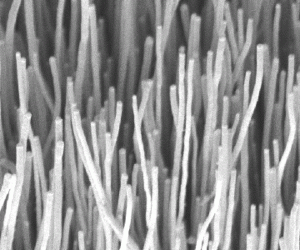Nanotechnology, the technology of the near future, has both positive and negative aspects. The nanotechnology used beneficially for human health is called nanomedicine. Nanomedicine will use engineered molecular systems and molecular knowledge of the human body to maintain and improve human health. Many scientists and physicians can use this technology as tools for disease diagnosis. They utilize nanofibers as biosensors. The majority of the biosensors are made up of polyaniline. Many products of using this new technology to further understand cell biology and manipulate or repair tissues within the body. A new application within the new technology is the use of quantum dots, q-dots. When excited with a laser, they admit light at a certain wavelength. With these new discoveries came another discovery. The scientists discovered that cells actually act in a group and move in packs: compartmentalized. Another invention, made by Carlo Montemagno, is the biobot. This robot is the tech of the future. During the inventive process, they first used mouse heart cells, which they grew on a metal plate showered with gold nanoparticles that adhere to cells. After these cells grow onto each other, they beat in sync and power the device. With this technology, the future may be the propellor for us to fly from reality to our wildest fantasies. Professor Godwin presented the information on fine silver nanoparticles used in clothing to eliminate bacteria, such as those causing odors. However, these silver nanoparticles are released into the water when washed and could potentially be harmful to the environment. One of Professor Rome’s most prominent discoveries is that of the vault. A vault is made from 3 proteins and a small RNA. These cells are hollow and are recognized and read by the body. The major vault protein, MVP, and two minor proteins, TEP 1 and VPARP, make up the vault. Because of the recognizable nature of vaults, they have the capacity to protect, regulate, and transport. These vaults can be utilized in the future as vectors to transport medicines such as chemotherapy and other anti-cancer drugs.



One Comment